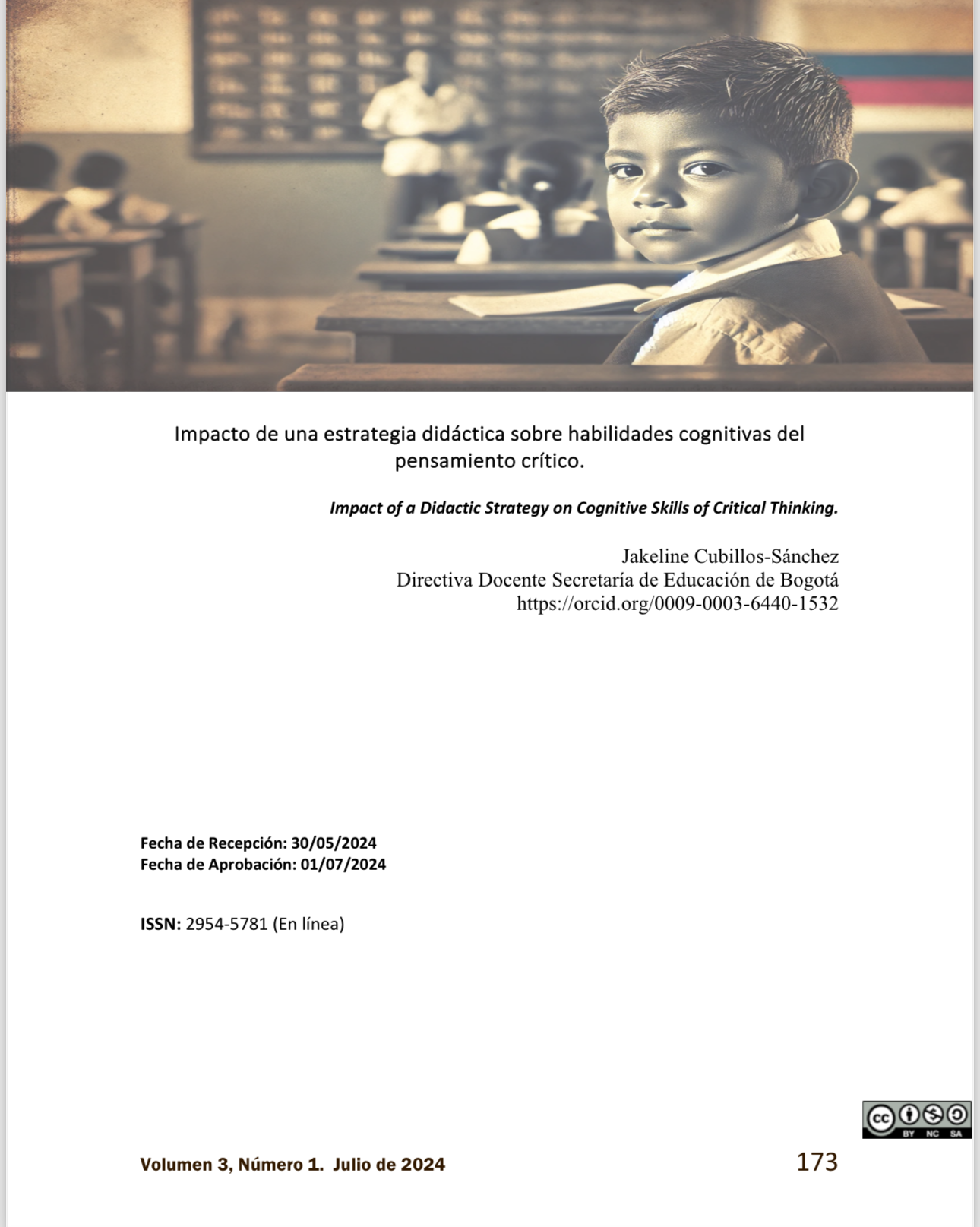Impact of a Didactic Strategy on Cognitive Skills of Critical Thinking.
Main Article Content
Abstract
The promotion of comprehensive education in the school environment requires the development of critical thinking in students, which today is seen as an educational urgency. This type of thinking enables the development of cognitive skills for processing information, evaluating judgments, arguing, and making decisions. Its development is urgent in the Latin American context so that young people have solid tools to exercise their citizenship critically and responsibly. Critical thinking, from a cognitive scientific perspective, involves the development of higher-order mental skills that facilitate informed decision-making, limit bias, and expand the understanding of phenomena of different natures. The purpose of the research is to analyze the effect of a didactic strategy based on constructivism, the scientific community of inquiry, and formative assessment on enhancing critical thinking as a 21st-century competency. This is achieved through the application of the Watson-Glaser Critical Thinking Appraisal to determine the curricular relevance of the proposal. Within the framework of a quantitative, quasi-experimental, cross-sectional, comparative-explanatory methodological design, the validated Watson-Glaser test is applied to 92 high school students. Data derived from the pretest and posttest are processed and analyzed using SPSS software, employing parametric statistics. The application of the test demonstrates the positive effect of the didactic strategy on enhancing students' critical thinking. It is concluded that such curricular proposals are pertinent in classroom work
Downloads
Article Details
Section

This work is licensed under a Creative Commons Attribution-NonCommercial-ShareAlike 4.0 International License.
Open Access Policy at Discimus Journal
Discimus Journal is committed to the promotion of free circulation of scientific and academic knowledge, simultaneously ensuring appropriate acknowledgment for our authors while adhering to the ethical principles of scientific publishing. In alignment with this goal, Discimus publishes all its articles under the ATTRIBUTION-NONCOMMERCIAL-SHAREALIKE 4.0 INTERNATIONAL CC BY-NC-SA 4.0
How to Cite
References
American Philosophical Association, (1990). Critical thinking: A statement of expert consensus for purposes of educational assessment and instruction. Documento reproducido por Educational Resources Information Center (ERIC), U. S. Department of Education.
Benavides C y Ruíz A. (2022). El pensamiento crítico en el ámbito educativo. Una revisión sistemática. Revista Innova Educación. ISSN-e 2664-1488, ISSN 2664-1496, (4) (2). 62-79
Cubillos-Sánchez J. (2022). Capítulo 6. Potenciando el pensamiento crítico: una experiencia en educación media en Maestros de lengua como agentes de cambio: reflexión e investigación en las aulas de clase. Tejada I, Peña B, Peña M (autores compiladores). Universidad de los Andes, Ediciones Uniandes; Medellín: Instituto Tecnológico Metropolitano. XXI, 205 páginas: ilustraciones; 17 x 24 cm. ISBN 9789585122765 (rústica) ISBN 9789585122772 (electrónico) https://doi.org/10.22430/9789585122772.06
De-Juanas, Ángel. (2013). Cuestionar las evidencias, educar en la reflexión: Robert H. Ennis, el estudio del pensamiento crítico y su influjo en la pedagogía del deporte RICYDE. Revista Internacional de Ciencias del Deporte, (IX, 33), 298-300 Editorial: Ramón Cantó Alcaraz Madrid.
De Zubiría S. (1997). Mentefactos i. Edición 1. Bogotá.
Doll, I., Parra, C. (2021). Impacto del desarrollo de habilidades de pensamiento crítico en la comprensión lectora de estudiantes de enseñanza básica. Nueva revista del pacífico, (75) (158-180). ISSN (E) 0719-5176 HTTP://DX.DOI.ORG/10.4067/S071951762021000200158
Ennis, R.H., Weir, E. (1985). The Ennis-Weir critical thinking essay test. Midwest Publications
Ennis R. (2005). Pensamiento crítico: un punto de vista racional. Revista de Psicología y Educación University of Illinois. (. 1,1), 47-64
Facione, P. (1990). Critical Thinking: A Statement of Expert Consensus for Purposes of Educational Assessment and Instruction. Research Findings and Recommendations. California Academic Press. https://eric.ed.gov/?id=ED315423
Halpern, D. (1998). Teaching critical thinking for transfer across domains dispositions, skills, structure training, and metacognitive monitoring. American Psychologist, 53(4), 449–455. Doi:10.1037/0003-066X.53.4.449
Leiva, C. (2005). Conductismo, cognitivismo y aprendizaje. Tecnología en Marcha. (18 1).
Lipman M. (1988). Philosophy goes to school. Library of congress cataloging-in-publication Data. ISBN. 0-8 7722-537-0
Lipman, M. (1991), Pensamiento complejo y educación, Madrid: Ediciones de la Torre. (Fragmentos)
Lipman, M. (1995). El pensamiento crítico: ¿qué puede ser? Itinerario Educativo, (28), 205-216
Lipman, M. (2016) El lugar del pensamiento en la educación. Barcelona: Octaedro.
López M, Moreno E, Uyaguari F, y Barrera M. (2021). El desarrollo del pensamiento crítico: Un reto para la educación ecuatoriana. Revista de filosofía, centro de estudios filosóficos, universidad del Zulia. 38(99), 483–503. https://doi.org/10.5281/zenodo.5656092
Meseger J., (2016). Pensamiento crítico una actitud. Universidad Internacional de La Rioja.ISBN: 978-84-16602-27-8.
Ossa-Cornejo, C., Palma-Luengo, M., Lagos-San Martín N., Quintana-Abello I., Díaz- Larenas C. (2017). Análisis de instrumentos de medición del pensamiento crítico. Ciencias Psicológicas,(11,1), 2017 Universidad Católica del Uruguay Dámaso Antonio Larrañaga. https://www.redalyc.org/articulo.oa?id=459551482003
Osorio J. (2020). Pensamiento crítico desde la psicología cognitiva; una desarticulación de lo crítico social y sus posibles implicaciones en la formación universitaria de Psicología. Revistan Andina de educación. https://doi.org/10.32719/26312816.2020.3.1.4
Saiz C, Fernández S. (2012). Pensamiento crítico y aprendizaje basado en problemas cotidianos. Revista de Docencia Universitaria. (10,3) 325 - 346 ISSN: 1887-4592. Universidad de Salamanca.
Tovstiga, G. (2012). Estrategia en la práctica: la guía profesional para el pensamiento estratégico. Buenos Aires: Granica. https://books. google.co.cr
Villarini A. (sf). Teoría y pedagogía del pensamiento crítico. Perspectivas psicológicas universidad de puerto rico. Perspectivas psicológicas. (3, 4. Año IV). 35-42.
Vygotsky, L. S. (1979). El desarrollo de los procesos psicológicos superiores. Crítica.
Vygotsky, L. S. (2002). Obras escogidas II. Visor.
Watson, G., y Glaser, E. M. (1980).Critical thinking appraisal, forms A and B. New York: Harcourt, Brace and Wold.

